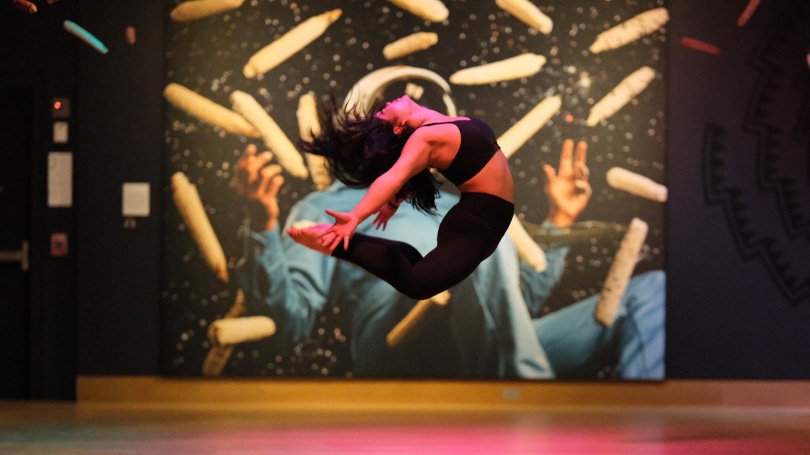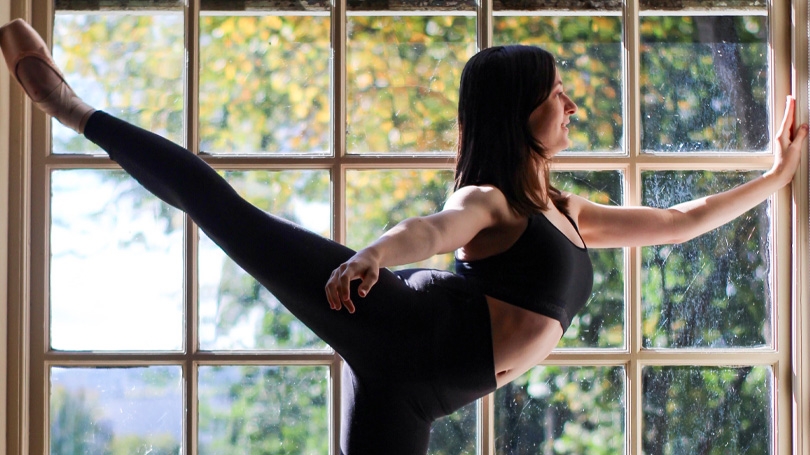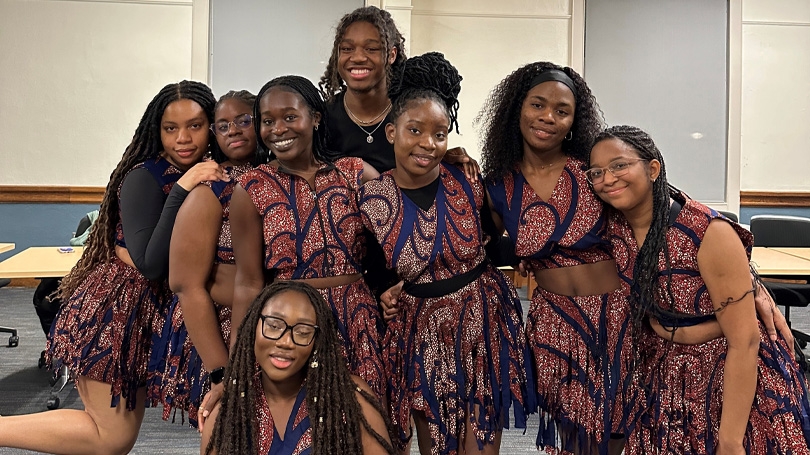Student dancers carve out spaces for self-expression and community
They leap and roll, twirl and contort. They dedicate hours on end to choreographing, learning, refining. Their artistry lights up every corner of campus, whether they are performing on a stage or in a fraternity.
Dartmouth's student dance groups vary in their main dance styles, which range from hip-hop and jazz to South Asian and Caribbean dance, as well as whether they are audition-based or open to all.
Raaz, a South Asian fusion dance group, and Soyeya African Dance Troupe, an African-American-based group, for instance, are cultural dance groups that emphasize their respective cultures in their performances.
As a fusion group, Raaz performs "a whole range of South Asian styles," including "different classical forms, such as Odissi, Bharatnatyam, Kathak," as well as Bollywood, hip-hop and Bhangra, according to Eiha Patnaik '25, former captain of Raaz.
"I feel like Raaz is a big part of South Asian culture on campus and that is how I've maintained my connection to the culture on campus," Patnaik added.
Soyeya African Dance Troupe "perform[s] routines from the entire diaspora," including Nigerian, Ghanaian, Kenyan and Caribbean dances, in hopes that their "audience learns a little bit more culturally after watching us perform," former co-captain Mirelle Mah'moud '25 said.
As opposed to Raaz and Soyeya, which are both audition-based groups, Street Soul is an open dance group which accept[s] anybody who wants to join, who wants to come have fun, learn how to dance, artistic director Harper Kucik '27 said.
Although Street Soul's primary focus is on hip-hop and commercial styles of dance, they also perform a variety of other styles, including K-pop-themed dances, modern, jazz and ballet since the group allows its members to choreograph in any style they wish.
The goal of the group is "to be here for anyone that wants to come in and to teach them what [we] can, and for it to be as open or as closed as they want it to be," said executive director Priyanshu Alluri '26, who originally joined Street Soul without any dance experience. "They can come in and stay for four years or come in for a term or even for a practice."
In addition to taking the stage, many student dancers have also tackled the creative challenge of choreographing.
Throughout her time in Raaz, Patnaik has choreographed many dances and found the process to be "really rewarding."
"It feels like a piece of my work, a piece of art," she said. "I like seeing a vision come to life—choosing music, figuring out … dance moves, figuring out how we want forms to be, who we want in what place. It's fun."
For Selena Han '25, former co-director and logistics director of Sheba Dance Troupe—a hip-hop, contemporary, jazz, commerical and street dance-focused group—the opportunity to envision and execute a dance is one she is "very grateful for."
"If you really think about it, it's a very precious opportunity," Han said. "If you just go out into the real world and say, 'I have a piece of choreo[graphy and] I'm going to have 20 other people learn it and perform it,' that's not really going to happen."
Fusion, a primarily contemporary, jazz, lyrical and ballet group, places an emphasis on inclusivity—their constitution states that any member who wants to choreograph a dance can do so and have it performed, according to Margaret Atkins '25, co-director of Fusion.
Similarly, Sugarplum, a contemporary and jazz group, hopes to create a "safe environment" for members to learn to choreograph while growing as dancers as artists, former co-director Rebecca Ronai '25 said.
While some dancers' experiences with the art form date back to a young age, others have found fulfillment in dipping their toes into the practice for the first time at Dartmouth.
Former Street Soul artistic director and current interim director Claire Green '25, who initially joined the group with no dance experience, has credited Street Soul with fundamentally contributing to both her personal and artistic growth.
"I think that chance to really grow as an artist and be able to express myself in this way that I never could before I came to Dartmouth is really powerful for my identity and my self-expression," Green said.
Similarly, Mah'moud did not have much dance experience before college, but she decided to give Soyeya a try during her sophomore summer at the encouragement of Soyeya's then-captain (and later, Mah'moud's co-captain).
"I ended up falling in love completely," Mah'moud said. "It was such a new experience, but it was a new experience with the best people, so it has been, honestly, probably one of my favorite things that I've done [at] Dartmouth today."
However, even those who came in with prior experience have found ways to stretch their boundaries as part of their dance group.
One of Fusion's goals is allowing their members, who boast a variety of backgrounds, including ice skating, aerial silks and gymnastics, to experiment with new styles of movement, Atkins said. Atkins herself had more previous experience with hip-hop as opposed to ballet and contemporary and joined Fusion as a way to try out dance styles she was less familiar with.
Given the vulnerability, teamwork and tenacity required to put on such high-quality performances, it is no surprise that these student groups have developed incredible communities, both within and outside of dance.
"Even practices [are] honestly more fun than [they] should be," Mah'moud said. "Sometimes we're like, 'Okay, we actually need to dance.' But I love it because it's literally me performing with my best friends, and we've created such a family within the dance troupe."
Spending six to 10 hours a week together, Raaz's members have developed a team that sticks with each other—even when they disagree, Patnaik said.
"These people are seeing sides of you that literally no one else on campus is seeing," she said. "You squabble, you fight with each other in a way that you would not fight with someone else … but at the end of the day, you're fine, because you're a team … it just brings out a level of emotions and feelings and I think even closeness that is really unique."
Street Soul's philosophy as an open group plays a major role in facilitating a "very welcoming, low key, chill environment," Kucik said.
"There's no pressure to perform a certain way," she added. "You don't even have to perform in shows if you don't want to … Everybody's just there to help each other, get better at dance, lift each other up."
For many groups, traditions also hold a special part in bringing members together.
Sheba, for one, holds naming ceremonies for their new members, or "newbies," at the end of each spring. Over dinner at Han Fusion, the group announces the newbies' new "Sheba names," which are "fancy dance name[s]" granted by other group members. However, they first prank the newbies with "really funny" fake names before finally revealing their real Sheba names, Han said, naming the ceremonies as her favorite Sheba memory.
In the fall, Fusion hosts a PowerPoint night for members to share yearly updates as well as to get to know the new members, which Atkins has hosted in her apartment's common room.
"We had to have multiple nights because people just want[ed] to share so much, which is awesome and I love that," she said.
Beyond each group's individual circle, the student dance groups have also worked to establish a larger student dance community. For instance, many groups host joint shows, during which both groups perform their sets as part of the same show—and, on occasion, even share the stage.
"[Raaz has] been having joint practices … with joint choreography and [it has] been super fun learning different styles from different groups and also teaching them a different style," Patnaik said.
Kucik recalled feeling more at ease during their first Street Soul performance, a joint show with Soyeya, due to their enthusiastic support.
"They were the loudest members of the audience by far; they were cheering so much,"
they said. "It just felt really nice to have a bigger dance community there for that show."
On a larger scale, all of the student dance groups join for SAUSSY, an annual outdoor dance show organized by Street Soul each spring. According to Green, the show "draws a huge crowd" and is her "favorite way that the whole dance community interacts together."
Hannah Krueger '26, co-director of Fusion, enjoys getting to witness the diversity of dance at such shows.
"I like … seeing that all of the other dance groups have their own styles, so just seeing all of them come together, especially for big performances like SAUSSY, is just so lovely," she said.
Every group undoubtedly possesses its own, unique fingerprint—yet at the end of the day, they are still bound together by one thing: their shared love and respect for the art.
"When I watch dance, it definitely makes me feel something," Ronai said. "The emotion you can convey through movement and facial expression and song choice and all those different things—I think it's super moving and it's also just fun to watch and dynamic."
Kucik credited dance with serving as "a creative outlet" and "stress reliever" from schoolwork.
"I can go dance in Sarner [Underground] at midnight if I need to and just let out whatever I need to, and then that can randomly be turned into choreography that we perform in a show a few weeks later, and that's so much fun," she said.
For Green, the degree to which dance requires and involves the body is unlike that of any other form of art.
"It's not just about how it looks, but that sensation, how you're actually moving your body and what it feels like and what it makes you feel, both emotionally and in terms of what muscles you're contracting and just letting relax," she said. "The way that the art form is so tied to your body—if there's any other art form like it, I don't know of it."





